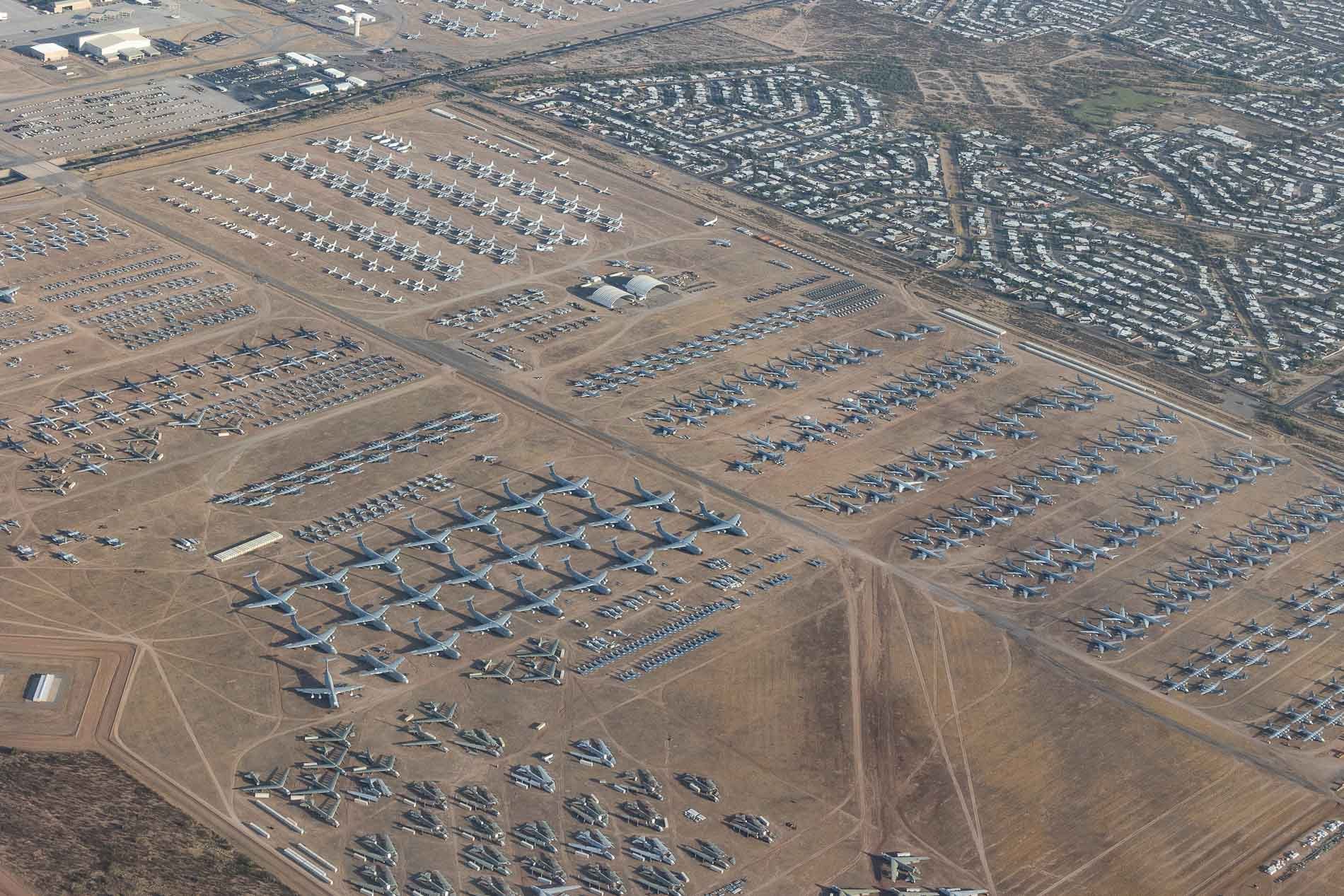
Davis-Monthan Air Force Base Airplane Boneyard Aircraft Boneyard 309th AMARG
February 1, 2023
Seeing The Airplane Boneyard From The Air – Aerial Photos Of The Airplane Boneyard
On a trip to Tucson, Arizona, I spent two hours at the Tucson airport monitoring the FlightRadar24. It was important to see which runway the early morning departures were using. I triangulated that with the location of the world’s largest airplane boneyard, located at Davis-Monthan Air Force Base. My goal as an aviation photographer was to capture an aerial view of this massive aircraft boneyard. I never thought I’d get to create my very own airplane boneyard aerial photos. I was wrong!

Aerial views of this graveyard of human engineering are even more amazing than I had expected! You can see the thousands of disused military aircraft beautifully lined up by type. The giant cargo planes all together really give you an idea of the immense size of this southern Arizona institution. Unfortunately, I wish I had more time to photograph this from the airplane, but I only had about 30 actual seconds. Good thing I came prepared to shoot this!

The beauty and symmetry of this desert icon are remarkable from the road and from the air. From the Southwest 737 I was flying on, I swear I shot these military planes for 1 continuous minute. I felt like I could see them forever, but my camera could only captures for a few seconds. The morning sunlight was casting beautiful shadows on the ground as well. Thee conditions were perfect to capture aviation photos of the coolest military aircraft boneyard in the world.

About Davis-Monthan Air Force Base Airplane Boneyard Aerial Photos
Davis-Monthan Air Force Base is a prominent and historic installation in the United States Air Force. Established in 1925, it has played a vital role in both peacetime operations and major conflicts. Home to the 355th Wing, this base is known for its exceptional support of combat airpower and global mobility. The vast expanse of the base harbors an array of aircraft, including the iconic A-10 Thunderbolt II, which showcases the base’s dedication to close air support missions. One night I went to a local casino, and the A-10s were so loud and fast, but I could not see them. It was eery.
Davis-Monthan Air Force Base also houses the 309th Aerospace Maintenance and Regeneration Group, famously known as the “Boneyard,” where retired aircraft find their final resting place. Beyond its military importance, the base contributes to the local community through various outreach programs and partnerships, making it an integral part of Tucson’s identity. Guided tours of the boneyard used to be offered. Tours are no longer offered, which is very disappointing.


Aircraft Boneyard Airplane Boneyard In Tucson Arizona An Aviation Photographers Dream Location
One of my aviation photography dreams came true in February 2022 when I visited Tucson Arizona. While driving around this amazing desert city in southern Arizona, I discovered that the United States Military’s aircraft boneyard at Davis-Monthan Air Force Base. I could not believe that thousands of mothballed aircraft were just yards away from me. The only issue was that I couldn’t get on base to photograph any of it. Tours are no longer permitted. The airplane boneyard In Tucson Arizona was a lifelong goal to see, so I spent hours trying.
I drove down every street, alley, and parking lot I could, to get as close as I legally could to the aircraft. Trespassing is never an option for me. I never thought I’d see it in person, only in the television shows that have featured it. But I finally found it, had my camera with me, and was there at the right time of day. I spent 2 hours on my first trip checking out every angle I could find. I held my camera up as high as I could and got it low to the ground. To ensure I didn’t trip any alarms, I made sure to stay back from the fences as well.
The photos below are the best airplane boneyard photos I could take from the ground. On another trip, I’d get the change to photograph this iconic aviation wonderland from the air.

About The Aircraft Boneyard In Tucson Arizona
The airplane boneyard just southeast of downtown Tucson used to offer tours, but they no longer do. I took the aviation photography images below without crossing any fences, barriers, or warning signs. Next time I visit Tucson, I’d love to tour this amazing aviation photography location sitting in the middle of Pima County and the Arizona desert. That assumes that tours have resumed.
Update: The aircraft boneyard tours were stopped sometime around Covid and have not restarted. This is disappointing but what can you do?
I hope this helped to answer “how do I photograph the aircraft boneyard in Tucson Arizona.” It is a question I finally answered after 30 years!


















Key Takeaways
- I captured stunning Airplane Boneyard Aerial Photos during a brief flight over Davis-Monthan Air Force Base in Tucson, Arizona.
- The boneyard showcases thousands of retired military aircraft, creatively lined up to highlight their massive scale.
- Davis-Monthan Air Force Base has historical significance and plays a key role in military operations, housing the renowned 309th Aerospace Maintenance and Regeneration Group.
- Tours of the boneyard are currently unavailable, making it difficult for aviation photographers to access the site.
- Despite challenges, I achieved a lifelong dream of photographing the airplane boneyard from the sky.
Check out my other professional aviation photography. #AVgeek #AviationPhotographer